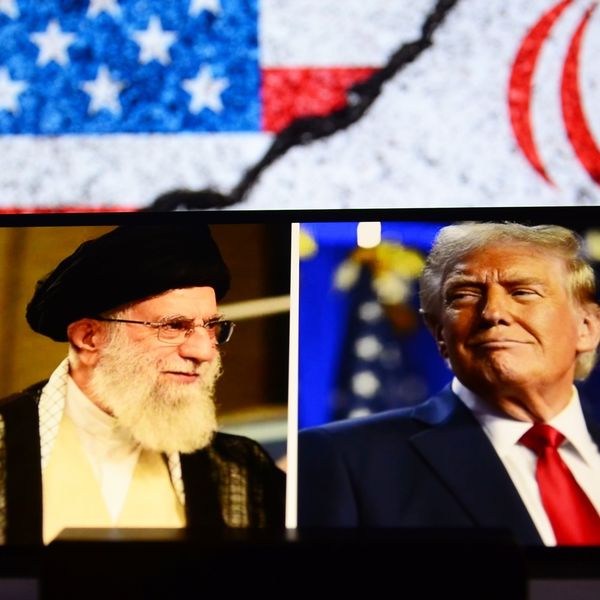America’s military community is abuzz just now with talk of the April Fool’s satire, “The Longest Telegram: A visionary blueprint for the comprehensive grand strategy against China we need,” published under the pen name C. Lea Shea, (cliche) in the usually staid War On The Rocks on the first day of the month.
The beauty of the essay lies not simply in its well-aimed witticisms (“more land wars in Asia”), and laugh-out-loud political commentary (“it is time for leaders in Washington to level with the American people and finally tell them the full, unvarnished truth: namely, that everything is China’s fault.”), but in its ability to snooker even the most discerning reader — including academics, historians, think-tankers, senior military officers and defense reporters — in its inauthenticity.
It’s hard to blame them. Or us. “The Longest Telegram” could easily double for a serious military paper that details America’s national security challenges — the kind of tome written by clipboard-wielding members of the Pentagon’s Joint Staff. It is filled with the cant usually reserved for acronym-toting colonels speaking Pentagonese, the lingua franca of the military-industrial-PowerPoint complex: “In the face of China’s anti-access/area denial (A2AD) capabilities, America needs to develop bold new war-fighting concepts of its own, such as accessible access/deniable denial (A2D2); Crouching Panda/Sleepy Eagle (CPSE); Flying Lotus/Downward Dog (FLDD); and Responsible Retaliation/Demolition Derby (R2D2).”
That such sardonic humor has gulled even the truly reflective should not come as a surprise. Just days before the article’s publication, Army Chief of Staff Gen. James McConville signed off on his service’s plans for fighting China, a 33-page salvo entitled “Army Multi-Domain Transformation.” The paper was not meant as satire, or poor wordsmithing, but it reads like it: “The Army’s ability to provide adequate forces hinges on the effective execution of all elements of force projection, such as mobilization, force projection, and sustainment of combat power.” In case you missed it: one of the elements of force projection is force projection.
Then there’s the snappy salute to the acronym addled (“PPPs, MFGIs, MOTs”) followed by tongue-tripping language lifted from Wall Street management manuals (“ready, resilient, and relevant”), before concluding with a patriotic appeal: “As we look to the future, we must not lose sight of the enduring lessons of our past: the American Soldier is the linchpin of our Army’s success. From Lexington and Concord, through the beaches of Normandy, to the mountains of Afghanistan, our People are ultimately what makes us successful.” That’s standard practice for the U.S. Army, where the word “soldier” is always capitalized, and now also for “people” — with a capital “P.”
We don’t expect our senior military thinkers to be stand-up comics, but we do expect them to be coherent. “Army Multi-Domain Transformation” is not.
The purpose of the Army paper is to propose a response to China’s anti-access/area denial strategy, which targets an aggressor with an overwhelming barrage of munitions (smart, supersonic and networked) to deny them access to a given area. The so-named A2/AD strategy resulted from China’s study of America’s tactics in Operation Desert Storm and now presents a suite of weapons to counter America’s ability to project power: anti-ship ballistic missiles, air and sea-launched cruise missiles, on-the-drawing-boards hypersonic glide vehicles, and heat-reading satellites that provide a defensive umbrella that can strike at anything that moves, or doesn’t. If-you-can-see-it-you-can-kill-it has been transformed — it’s now possible to kill something you can’t see.
The U.S. Army’s “Multi-Domain Transformation” is meant to be a solution to this, but that seems only notionally true: instead of fighting its way into an anti-access umbrella, the report says, the Army would preposition its forces inside the enemy’s defenses and hunker down. The opening barrage of any future war would presumably kill most of the these soldiers, but some would remain. More simply, the goal of this “inside force,” as defense reporter Sydney Freedberg notes, is to provide a foothold that creates “an opening in the foe’s defense into which US reinforcements can flow.” But even with that, the Army’s plan seems stillborn: reinforcements to do what?
The “Multi-Domain Transformation” paper appears to be a follow-on from a 2017 Rand Corporation analysis that recommended that the Army develop new structures (multi-domain fire battalions) and technologies (improved long-range missiles) to counter the A2/AD challenge. But nowhere in that study was there a suggestion that the Army actually preposition its forces inside a potential enemy’s defenses, or precisely how that might be done. Which may be why the earliest critiques of the Army’s proposal have been so dismissive.
“The only way to get inside of China’s anti-access umbrella is to station our troops in Shanghai — a deployment the Chinese are unlikely to allow,” a senior civilian Pentagon advisor tells Responsible Statecraft. “I agree: we need to pre-position our military forces to areas where they can survive. But where exactly would that be?”
The critique seems justified, as the paper suggests that the Army’s true adversary is not Russia, China, or Iran — or any other potential adversary that is developing anti-access and area denial weapons. The true adversary is the Air Force and Navy, the services that will do the heavy lifting in any future engagement against a hyper-sonically networked foe. That view is hardly controversial, as it was endorsed by McConville’s predecessor, former Army Chief of Staff (and current JCS Chairman), Gen. Mark Milley. "Look, I'm an Army guy,” Milley said back in December. "And I love the Army. But the fundamental defense of the United States and the ability to project power forward will always be for America naval and air and space power." The “Multi-Domain Transformation” paper is the Army’s response: it’s a poorly disguised bid to be dealt back into the Pentagon budget game.
Ironically, on the day that War On The Rocks published its send-up of the blob’s adoption of Pentagonese, Senator James Inhofe weighed in on the China challenge. “Joe Biden has talked the talk about pushing back against Chinese aggression,” he wrote in the pages of Newsweek, “but the real marker of whether his administration is serious about competition with China will be its proposed defense budget.”
Inhofe’s conflation of presumed Chinese aggression with competition was no doubt purposeful, but it was also suggestive: tax dollars are now as important in the China “competition” as long-range precision fires, next generation combat vehicles, or soldier lethality. For Inhofe, it seems, the key is to forward deploy pro-defense votes underneath Biden’s appropriations umbrella: “If the United States responds (to Chinese “aggression”) with a budget cut instead of a corresponding investment, it would send a terrible signal to Beijing.”
It’s hard to miss Inhofe’s point: increased defense spending (an “investment”) equals increased security. The claim is nonsensical. If China can spend one-third of what we spend on defense, but is close to outstripping us in capabilities (as any number of senior officers and their Congressional allies claim), then perhaps we should do the same. In fact, Inhofe’s claim is a perfect reflection of the problem. The U.S. military is in love with more, and (at least since the end of the Cold War) always has been, with more tanks, jets, bombers, ships and (recently) soldiers added to a force that is struggling to be smaller, lighter and more lethal.
What is particularly shocking about this is that while our military’s senior officers have urged us to remember “the enduring lessons of our past” (as Gen. McConville phrases it), the key to American military dominance has always been better, not more. It is America’s qualitative edge that has proved the difference in previous conflicts, and was the difference in driving the Soviet Union to bankruptcy in the Cold War. Or perhaps the claim that China is within spitting distance of matching our capabilities is simply false. Certainly, the Chinese think so. In 2017, General Secretary Xi Jinping announced that China’s goal was to build a “world class” military that would be equal to the U.S. military by 2049 — more than 25 years from now.
So if that’s true, if Xi Jinping is providing a more sobering analysis of Chinese military capabilities than is acknowledged by the Pentagon, why is there a nearly breathless scramble to identify and fund new weapons systems? The answer is obvious, even to senior military officers who have spent the last weeks eyeballing Gen. McConville’s “Multi-Domain Transformation” paper. What is at stake here, they argue, is not more defense, but more dollars. McConville confirms the claim, if only inadvertently. Two-thirds of the way through the transformation paper, he lays out the Army’s requirements: investments in “long range precision fires,” purchases of “next generation combat vehicles,” deployments of “future vertical lift platforms,” funding for “network modernizations,” monies for increased “air and missile defense capabilities,” and appropriations for improvements in “soldier lethality.”
The list of requirements is the service’s telltale: the paper is a shot across the bow of the Air Force and Navy in the Pentagon’s already roiling budget wars. A senior retired U.S. Army officer is more forthright: “The Army doesn’t have a military strategy,” he says, “it has a spending strategy.”














